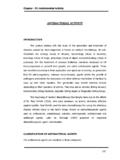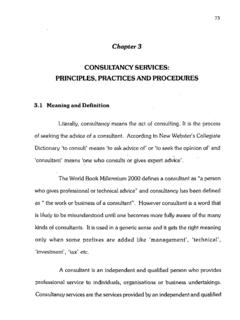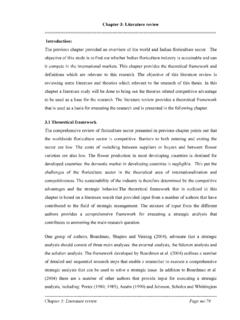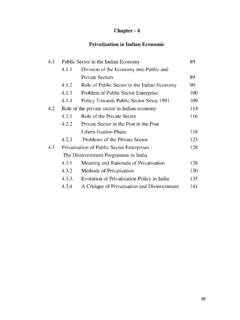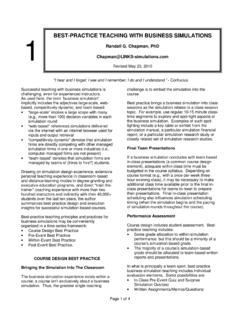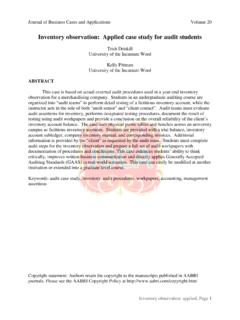Transcription of CHAPTER I TRAINING AND DEVELOPMENT: A …
1 17 CHAPTER I TRAINING AND development : a conceptual framework A manager develops people. How well or how poorly subordinates develop themselves in their work depends on the way a manager manages. A manager: Directs people or misdirects them; Brings out what is in them or stifles them; Strengthens their integrity or corrupts them; Trains them to stand upright and strong or deforms them. Every manager does these things knowingly or not. A manager may do them well, or may do them wretchedly, but always does them . Peter F. Drucker Introduction In the world of TRAINING and development , impact measuring program is a frequent discussion topic.
2 Everyone seems to be searching for the perfect measurement system to increase organizational capabilities, performance and link them with the business strategy. Human resource practitioners, organization development consultants, TRAINING managers, and senior managers realize that any TRAINING and development activities should eventually show a positive return and improve the bottom line. Hence, the TRAINING and development has an important role in the human resource management. It is generally agreed that human beings began amassing knowledge at the beginning of the stone-age.
3 As they invented tools, weapons, clothing, shelter and language, the need for TRAINING became an essential ingredient in the march of civilization. However, our ancestors stumbled upon or invented the various facets of civilization, which are very little significance, they transmitted the knowledge and skills acquired by them from generation to generation. This 18 was done through various methods. Through these methods, the development process called TRAINING came into operation. Before industrial revolution the methods of TRAINING in agriculture, trade and business, crafts were not very formal.
4 The techniques were learnt from father to son gradually through practice. The experienced persons were highly recognized in these fields. Historical growth of TRAINING and development The twentieth century saw dramatic changes within the world of work, and the twenty-first appears to have continued the theme of change. Organizations have evolved in terms of purpose, size, structure, management philosophy and relationships with the outside world. Technological advances have revolutionized all work methods, and for many organizations the operational horizon has moved from a small geographical area to literally the world; for government, 'being competitive' is now a global (as opposed to a selective international) requirement.
5 Everything has speeded up, including the pace of change itself. It is natural that in a period of change and opportunity, approaches to learning, development and TRAINING have grown in importance, broadened in scope, and became more sophisticated in method. Once the object of TRAINING would have been the individual employee, and the TRAINING method would involve teaching. Now, the picture is much more complex: TRAINING may involve any grouping up to and including the nation itself, and even sometimes may have an international dimension. It may also extend to non-employees such as suppliers, customers or outsourcers.
6 Learner-centered 19 activities are becoming just as important as if not more important than, those that are teacher or tutor led. Learning is no longer mainly the province of the psychologist or sociologist: researchers in fields such as systems engineering, artificial intelligence, cybernetics, communications technology, management and even biology have extended relevant theory by drawing on their own specializations, extending and modifying ideas originally geared only to a human dimension. The organisations think of individuals as being 'able to learn', and indeed of both as being capable of 'learning to learn' - which means much more than acquiring knowledge of how learning happens.
7 Three fundamental (and to some extent contrasting) ideas have grown in importance over the last 20 years or so. The first is that the continuously changing environment demands lifelong learning on the part of all - even governments are aware that this is a key to future prosperity, and are attempting to promote it widely. The second is that real-life experience itself offers significant learning opportunities, and that experiences can be designed to stimulate learning - hence more emphasis on the learner than the trainer. The third is that the government should create and encourage national vocational schools to improve occupational competence, and they should be recognized by the award of national vocational qualifications (NCL, 2002).
8 To understand the reasons for these diverse developments, and how they have gathered momentum in recent years, they will be briefly reviewed by their evolution, focusing on the key themes that have emerged from almost a hundred years of thinking about learning, and showing how and where these have influenced trainers and educators in achieving their aims. 20 After industrial revolution, machines were used in various fields and formal TRAINING process came into operation. In the beginning phase of industrial revolution the machine system of production was confined to industrial sector.
9 Gradually highly developed techniques were applied in the fields like agriculture, fishing, forestry, etc. The importance of TRAINING in the industrial sector is explained in the theory of "Scientific management" given by Taylor (1967). His theory explained about the importance of TRAINING for high productivity, low accident rate, low wastage and maximize profit. He emphasized on the need for special TRAINING of the production line workers for a specific job. The substitution of machine power for people power, required more specialized hands. Adam Smith and Taylor (1967) wrote on the importance of specialization for increasing efficiency.
10 Babbage (Wikipedia) in his work "On the economy of machinery and manufacturers" listed six reasons for making jobs as specialized as possible and all these reasons imprinted the essence of TRAINING . Babbage (1997) has given more emphasis on specialized TRAINING than general TRAINING . To support his argument he says that specialized TRAINING requires less time and less wastage of material. TRAINING gained importance during the world wars. World War-I promoted a tremendous stimulus for TRAINING . To fulfill the sudden demand of military requirements, the organizations set up TRAINING wings to train new workers to meet the challenges of huge supplies of war front.
